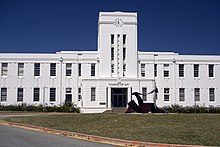loading...
Thursday, 5 November 2015
Australian National University

Post-war origins
Calls for the establishment of a national university in Australia began as early as 1900. After the location of the nation's capital, Canberra, was determined in 1908, land was set aside for the university at the foot Black Mountain in the city designs by Walter Burley Griffin. Planning for the university was disrupted by World War II but resumed with the creation of the Department of Post-War Reconstruction in 1942, ultimately leading to the passage of the Australian National University Act 1946 by the Parliament of Australia on 1 August 1946.

A gathering of famous Australian researchers came back from abroad to join the college, including Sir Howard Florey (co-designer of therapeutic penicillin), Sir Mark Oliphant (an atomic physicist who took a shot at the Manhattan Project), Sir Keith Hancock (the Chichele Professor of Economic History at Oxford) and Sir Raymond Firth (an educator of humanities at LSE). Business analyst Sir Douglas Copland was selected as ANU's first Vice-Chancellor and previous Prime Minister Stanley Bruce served as the first Chancellor. ANU was initially sorted out into four focuses—the Research Schools of Physical Sciences, Social Sciences and Pacific Studies and the John Curtin School of Medical Research.
The principal inhabitant's corridor, University House, was opened in 1954 for employees and postgraduate understudies. Mount Stromlo Observatory, set up by the central government in 1924, turned out to be a piece of ANU in 1957. The main areas of the ANU Library, the Menzies and Chifley structures, opened in 1963. The Australian Forestry School, situated in Canberra since 1927, was amalgamated by ANU in 1965.
Canberra University College
Canberra University College (CUC) was the first organization of advanced education in the national capital, having been set up in 1929 and selecting its first undergrad understudies in 1930. Its establishing was driven by Sir Robert Garran, one of the drafters of the Australian Constitution and the first Solicitor-General of Australia. CUC was partnered with the University of Melbourne and its degrees were conceded by that college. Scholastic pioneers at CUC included history specialist Manning Clark, political researcher Finlay Crisp, artist A. D. Trust and financial specialist Heinz Arndt.
In 1960, CUC was incorporated into ANU as the School of General Studies, at first with resources in expressions, financial matters, law and science. Resources in Oriental studies and designing were presented later. Bruce Hall, the first private school for students, opened in 1961.

Modern era
The Canberra School of Music and the Canberra School of Art were amalgamated by ANU in 1992.
ANU set up its Medical School in 2002, in the wake of getting national government endorsement in 2000.
On 18 January 2003, the Canberra bushfires to a great extent demolished the Mount Stromlo Observatory. ANU stargazers now lead research from the Siding Spring Observatory, which contains 10 telescopes including theAnglo-Australian Telescope.
In February 2013, monetary business visionary and ANU graduate Graham Tuckwell made the biggest college gift in Australian history by giving $50 million to support an undergrad grant program at ANU.